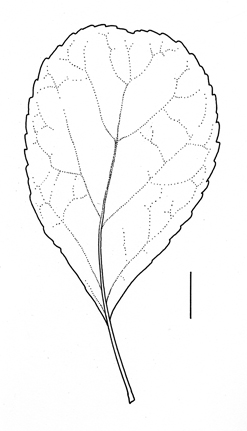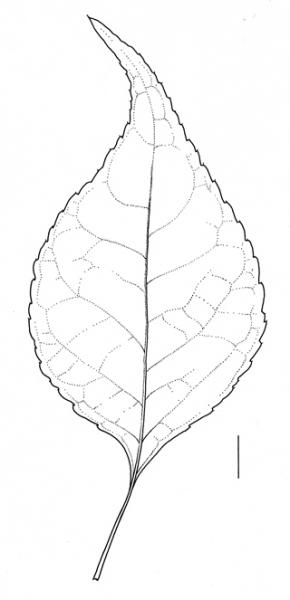Celastrus orbiculatus
Celastrus orbiculatus Thunb. (syn.: C. articulatus Thunb.) (E-As.) – An exceptional, more or less established escape from cultivation. Discovered in 2004 on the edge of a nature reserve in Berchem-Antwerpen (Wolvenberg). Very persistent and still present today (last checked in 2010; comm. E. Molenaar) despite the regular use of herbicides. It very locally climbs in native as well as planted shrubs and trees (in half-shade). In 2005 also recorded in the valley of river Schelde in Berlare (Paardebroek; a single specimen, ca. 6m tall) and in 2013 in Lommel (Den Tip), probably as a relic of former cultivation but regenerating.
Celastrus orbiculatus apparently hardly flowers in its few Belgian locations and further spreading by sexual reproduction therefore seems rather unlikely. However, it is very persistent: in Berchem its eradication seems impossible. In many parts of the world, including North America (Sarver & al. 2008) and New-Zealand (Williams & Timmins 2003), Celastrus orbiculatus is an invasive species.
 |
 |
 |
 |
 |


Literature:
Adolphi K. (2015) Anmerkungen zu einigen sich möglicherweise einbürgernden Neophyten. Braunschweiger Geobotanische Arbeiten 11: 137-153. [available online at: http://digisrv-1.biblio.etc.tu-bs.de:8080/docportal/servlets/MCRFileNodeServlet/DocPortal_derivate_00036754/11_Adolphi.pdf;jsessionid=273AC2D45111D31FF7709A7B7BCAB9A5]
Adolphi K., Kasperek G., Dickoré W.B. & Kremer B.P. (2012) Ein großflächiges Vorkommen von Celastrus orbiculatus (Rundblättriger Baumwürger) auf aufgelassenem Bahngelände in Neuwied (Rheinland-Pfalz). Florist. Rundbr. 45-46: 1-14.
Červinka Z. & Sádlo J. (2000) Neofyty Ambrosia psilostachya a Celastrus orbiculatus v městě Čelákovicích. Muz. a Současnost, ser. natur. 14: 65–68.
Del Tredici P. (2014) Untangling the Twisted Tale of Oriental Bittersweet. Arnoldia 71(3): 2-18.
Sarver M.J., Treher A., Wilson L., Naczi R. & Kuehn F.B. (2008) Mistaken identity? Invasive plants and their native look-alikes: an identification guide for the Mid-Atlantic. Delaware Department of Agriculture and USDA Natural Resources Conservation Service: 62 p.
Williams P.A. & Timmins S.M. (2003) Climbing spindle berry (Celastrus orbiculatus Thunb.) biology, ecology, and impacts in New Zealand. Science for Conservation 234: 28 p. (http://www.doc.govt.nz/upload/documents/science-and-technical/sfc234.pdf).

